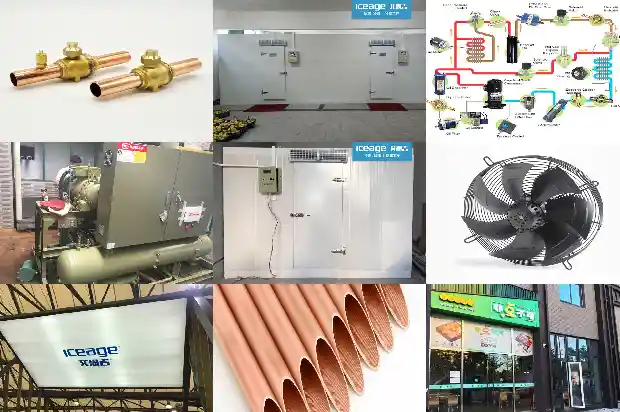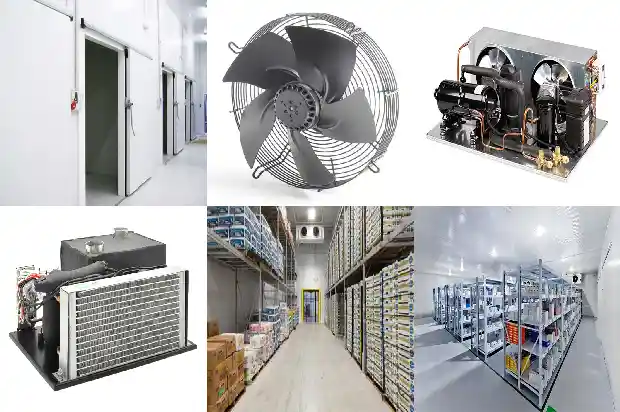Several Common Problems in the Operation of the Refrigeration System
2025-03-12
During the operation of the refrigeration system, the following common problems usually occur:
- Insufficient Refrigerant in the System
It is mainly manifested as poor refrigeration effect of the system, slow decrease in the refrigeration temperature, low low-pressure, small refrigeration capacity, and the refrigeration temperature failing to reach the ideal range. The evaporation temperature at the refrigeration temperature does not match the pressure corresponding to the refrigerant used. The suction temperature of the compressor is high, the suction (return air) superheat is large, the body of the compressor heats up severely, even gets hot, and the hermetically sealed compressor is likely to trip due to overheat protection at this time. The low-pressure part of the system does not frost where it should, especially the rear end of the evaporator does not frost completely. Bubbles can be seen flowing in the liquid sight glass of the liquid supply pipe. The reasons for these phenomena are sufficient to indicate that there is insufficient refrigerant in the system. When such a situation occurs in the system, refrigerant should be added to the system in a timely manner to ensure the normal and stable operation of the system and the economic efficiency of its operation. - Excessive Refrigerant Charge in the System
It is mainly manifested as poor refrigeration effect of the system. Due to the increase in the liquid level entering the evaporator, the evaporation pressure and the low-pressure are higher than the normal values, the load of the compressor is large, the running current is high, the running sound is dull, and the running temperature is also high. If too much refrigerant is charged into the system, some phenomena will be opposite to those of the previous situation. The compressor has a low suction temperature and a small suction (return air) superheat, resulting in the body of the compressor frosting and operating in a wet stroke state. This leads to the system's working conditions not conforming to the actual situation, a decline in the compression performance of the compressor, a slow decrease in the refrigeration temperature, or even no decrease, and extremely poor refrigeration efficiency. The front part of the evaporator does not frost, while the end of the evaporator to the compressor frosts, which are all extremely abnormal phenomena. The main reason for these phenomena is excessive refrigerant charge in the system. It is necessary to find a way to recover or remove the excess refrigerant to ensure the safe, stable, and normal operation of the system. - Non-condensable Gases Mixed into the Refrigeration System
Due to careless operation, leakage, incomplete vacuum, and other reasons, air or other dirty gases (collectively referred to as "non-condensable gases") enter the system. It not only occupies a certain volume of the system but also reduces the refrigeration efficiency, raises the condensing pressure, causes the pointer of the pressure gauge to jump violently, and affects the safe and stable operation of the system.
Compare the measured condensing pressure (high-pressure) with the corresponding pressure at the ambient temperature at that time. The difference between the two is the content of non-condensable gases in the system. For example, the measured condensing pressure of a certain R22 system is 13.2 kg/cm² gauge pressure, and the ambient temperature at that time is 35 degrees. Check the temperature-pressure comparison table of the R22 refrigerant. The corresponding saturation pressure at a temperature of 35 degrees is 12.81 kg/cm² gauge pressure, which is lower than the measured condensing pressure, indicating that there are non-condensable gases in the system. The pressure content of the non-condensable gases is: 13.2 - 12.81 = 0.39 kg/cm² gauge pressure. The methods of identification and detection are simple, practical, and useful.
Discharge of Non-condensable Gases: For standardized refrigeration systems of medium size and above, air separators are generally installed in the system. The non-condensable gases can be directly separated and discharged from the air separator (air separator) according to the operation procedure for the discharge of non-condensable gases. For small systems or systems without an air separator, the discharge should be carried out at the air vent at the highest point of the system during the period with the lowest air temperature and the longest system shutdown time. The discharge can be carried out several times until it is felt that the discharge port becomes cool and it is considered that the non-condensable gases have been basically exhausted. Non-condensable gases are likely to separate naturally from the refrigerant when the system is stationary at a low temperature.
Their specific gravity is smaller than that of the refrigerant, and after separation, they gather at the high point (upper part) of the system. Therefore, the discharge should be carried out at the air vent at the highest point of the system during the period with the lowest air temperature and the longest system shutdown time. It is also possible to directly open the valve above a certain container in the system for discharge, or discharge the gases from each container one by one. When discharging, the vent valve should be opened carefully, slowly, and appropriately. Do not open it suddenly or too wide to avoid the refrigerant being discharged from the system at the same time as much as possible.
- The "Ice Blockage" Phenomenon in the Refrigeration System
When the moisture in the fluorine refrigeration system reaches a certain proportion (amount), the phenomenon of blockage caused by the condensation of water at the throttle outlet (expansion valve or capillary tube) end or in the narrow passage of the expansion valve is called ice blockage. After the ice blockage is formed, the low-pressure becomes lower, even negative pressure, the refrigeration effect is poor or even there is no refrigeration, the current of the compressor is low, there is only a weak hissing sound in the expansion valve or capillary tube or there is no response at all, the temperature difference between the connecting pipes before and after the throttle is small, or even there is no temperature difference, the evaporator does not frost, the outlet of the compressor and the condenser are not hot. After the ice blockage, it will take a long time for it to melt and be unblocked by itself, but the ice blockage will occur again after the system circulates for a while.
There are many methods to eliminate ice blockage, but the workload and difficulty are also relatively large. According to the degree of ice blockage, compressed air that has been dried or, if possible, nitrogen can be used to repeatedly flush the ice-blocked system; methods such as baking (roasting) treatment, drying treatment, replacing the desiccant or the dryer-filter, and replacing the lubricating oil can be adopted until the ice blockage phenomenon is completely eliminated.
- The "Dirt Blockage" Phenomenon in the Refrigeration System
When the oxides and other impurities and dirt in the system continuously circulate with the refrigeration working medium and gradually accumulate in the liquid outlet filter (screen) or in the narrower parts of the system (such as the throttle passage), blockage is likely to occur, and this phenomenon is called dirt blockage. After the dirt blockage occurs, the low-pressure becomes lower or even negative pressure, the temperature difference between the connecting pipes before and after the throttle is small, or even there is no temperature difference; the refrigeration effect is poor or even there is no refrigeration at all, the current of the compressor is low; there is only a weak hissing sound in the expansion valve or capillary tube or there is no response at all, the evaporator does not frost, the outlet of the compressor and the condenser are not hot; if the dirt blockage is before the end of the condenser, it will cause the condensing pressure to rise, and the working conditions of the system will be very bad. Different from the ice blockage phenomenon, the system with dirt blockage generally will not be unblocked by itself.
For slight and general dirt blockage, compressed air with a pressure of 0.8~1.6 MPa that has been dried or, if possible, nitrogen with the same pressure can be used to repeatedly and quickly flush the system. When dredging with air pressure, a sledgehammer can be used to gradually knock on the blocked pipeline or part to flush out the blockage through vibration until it is completely unblocked. For pipelines or components that are firmly blocked and cannot be unblocked, they can only be removed and replaced.
Related Articles
- HVAC - Solving the 5 Common Problems in the Refrigeration System
- Five Common Problems in the Refrigeration System~~ Solve Them One by One!
- Have You Encountered the Three Common Problems of Refrigeration Compressors?
- Comprehensive Guide to the Operation and Maintenance of Cold Storage
- What Factors Affect the Abnormal Operation of the Control Valve in the Cold Storage?
- Operation and Maintenance Process of Cooling Towers
- Analysis of the Composition, Control and Operation Process of Cold Storage System
- Reasons for Compressor Oil Deterioration and Oil - adding Operations
- Operation and Precautions of Frozen and Refrigerated Auxiliary Equipment
- Oil Cooling Methods and Oil - changing Operation Procedures for Screw Compressors
- Refrigeration System: Copper Pipe Welding and Flushing Operations
- Essential for Maintenance! Parameters and Phenomena of Normal Operation of Refrigeration and Heating Systems
- What is the Correct Operation Method of the Distribution Box during Cold Storage Installation?
- Operation of Screw - type Water - cooled Chiller Units
- Considerations in Selecting Packaged Air Conditioners and Their Heat Recovery Operations
- Common Malfunctions in the Operation of Cold Storage
- What Are the Three Essential Conditions for the Safe Operation of the Refrigeration System?
- Common Issues in Chiller Operation and Solutions
